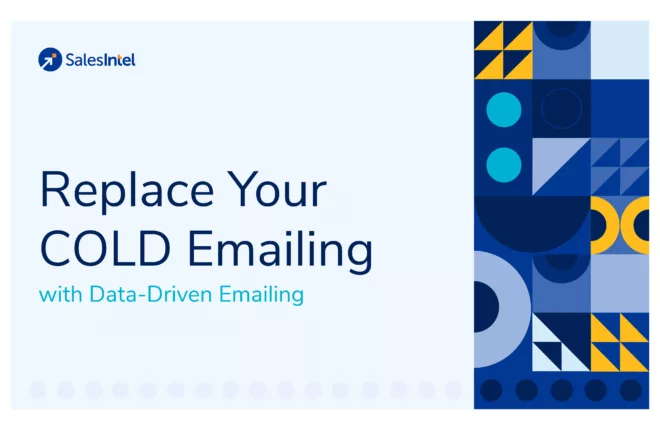SalesIntel’s strategic partnership with Semcasting empowers B2B marketers with high-quality account technographic and job title data to leverage in their paid channel efforts. The integration of SalesIntel business intelligence into AudienceDesigner by Semcasting (ADS) brings actionable account technographic data to our clients to improve their top-of-funnel prospect quality, scale of coverage and digital reach.
We hope you will join SalesIntel’s CMO, James Lamberti, and Mike Skladony, GM of Consumer Services, Semcasting for our upcoming webinar on April 20 at 1pm ET, “B2B Efficiency at B2C Scale: How B2B Marketers Can 2X Their Pipeline Using Programmatic Advertising.” Mike and James will showcase how programmatic advertising is a viable, scalable, and efficient approach to driving the pipeline for B2B marketers in 2023 (not just B2C marketers!)
Register for the webinar here: https://hubs.ly/Q01GzXXR0.
In the meantime, please enjoy getting to know more about Semcasting’s GM of Consumer Services, Mike Skladony.
What differentiates Semcasting in the B2B programmatic ad world?
A: Like we’ve done with all our solutions and products at Semcasting we looked at the industry, and we said, how can we help, where can we provide value for brands and advertisers and ultimately how do we differentiate to get attention? B2B really wasn’t different from our consumer products. We have this deep and rich history in offline and online consumer targeting, so we looked at the industry, and we said everyone is treating B2B prospects like they’re some sort of segmented foreign class and we looked at each other and said, well, I’m human and you’re human. You go on vacations, I go on vacations, you watch Hulu, I watch Netflix, let’s build a solution that helps brands engage with their prospects not only in offices but also when they’re at home. The pandemic helped propel this methodology because now you’ve got large portions of the workforce that are WFH or Hybrid. Our ability to link employees to their homes and cross-device within those homes at a reasonable scale gives brands and advertisers a complementary approach to other tactics they’re implementing whether it be ABM or ads placed with direct publishers or spending on LinkedIn.
What is unique about working within the B2B v. B2C marketing space?
A: I kind of addressed this above, but it’s really about this notion of presenting B2B advertisers with this idea that B2B prospects are really just consumers. You can engage them beyond their work emails and outside of very specific endemic publisher content. When you can link B2B prospects to their homes, brands need to start to embrace the fact that their ad about ERP solutions showing up on a publisher site about travel or Sports content is OK because you’ve got the targeted audience behind it and that “decision maker” you’re looking to engage is just like you, they look at all kinds of web content in their day to day. I’d say overall, we’re seeing less apprehension over this than we did three years ago.
Why should B2B marketers be experimenting with B2C Paid Advertising strategies?
A: They should experiment first and foremost because the capability is there and tracking exists. We’ve seen B2B advertisers promote on linear TV for decades, targeting a whole market worth of consumers for a product that relates to 1% or less of that population. Now that brands have the ability to custom-build a segment of the exact households that hold their prospects, they can optimize those media dollars across most digital channels.
When should an organization consider leveraging programmatic efforts in their go-to-market strategies?
A: Brands should consider programmatic whenever there is a brand-building need and certainly when they need to continue to fill the top of their marketing funnel. Display advertising sometimes gets a bad rap, people want to throw it under the bus all the time, particularly in B2B where there is this heavy emphasis on demand generation and lead generation. Candidly I don’t think I’ve ever clicked on a display ad and purchased a product or service from that click, but I’ve certainly gone back to sites or searched for them, coming back through what would be lower funnel marketing channels. So as long as the brand understands what to expect from Programmatic and its function, it’s ideal to add to their marketing mix.
How do you evaluate data partnerships? How did that evaluation process lead you to select SalesIntel as a partner?
A: It always helps when you get an introduction from someone you know, which is what happened here when I was introduced to SalesIntel through a mutual acquaintance. I had a couple of Zoom conversations with Manoj Ramnani. Then I was fortunate enough to meet him in person at a conference where I also got to speak with some users of the SalesIntel platform who spoke highly of the data quality compared to other competitors in the space. There has been a client ask on my side of the business for more access to job title data and technographic data across programmatic. After doing some test matching with SalesIntel, it was an obvious fit to partner.
What are some major challenges that you (and/or other advertisers/marketers/data industry) face today?
A: Privacy and particularly consumer privacy is something that looms heavily across our entire industry. It’s something that’s at the forefront of everything that we do, being a data provider ourselves. More importantly we’ve implemented policies and achieved certifications like Soc2 Type2 which allows us to safely handle sensitive consumer data. We achieved this certification as a requirement to work with some top-tier financial institutions and healthcare insurers, but it covers the entire scope of our business.
What trends are you keeping an eye on over the next year? Five years?
A: CTV/OTT is an exploding market for brands and advertisers, particularly as linear takes a hit we’re seeing advertisers shift dollars. As I touched on prior, the capabilities we’re bringing to the table with SalesIntel data included open the door for B2B brands to engage across this type of media with confidence. We’re also working on solutions to address issues associated with cross platform frequency capping that will come out later this year, which will further help brands leverage their marketing dollars across various digital platforms they may be leveraging.
How is it that B2B Marketers should work with Semcasting to leverage SalesIntel data for their programmatic spend?
A: It starts with having a conversation about what you have implemented now and what you’re looking to do in the coming months and years. You’re welcome to reach out to us directly or work with your contacts at SalesIntel to get this process started.
One of the most valuable things we’re bringing to the table here is that we’re agnostic in how you want to leverage this data programmatically. Lots of brands are building out in-house teams that run and manage their programmatic media. This is great to see. We’re able to support these teams with direct syncs to a number of DSP platforms to push the data into your advertiser seat. We also have a self-serve platform called Audience Designer by Semcasting where qualified brands can get a license log in and access a wide variety of pre-packages SalesIntel data (job titles and technographic data segments) to custom create their audiences and deploy them to their desired digital platform.
For Brands who don’t have their own programmatic media buying teams, Semcasting has a team of expert campaign managers who have seats across a variety of DSP platforms, and we can discuss a way to leverage SalesIntel data through a managed services buy.
How did you get started in the advertising/marketing/data industry?
A: I was just about to graduate college with a Business Degree, not much of a plan. I had been teaching snowboarding in the winter months and landscaping in the other months. I had ZERO advertising and marketing skills but I could teach a 5-year-old how to shred the bunny hill and I could dig a ditch. One of my landscaping clients I had known for several years offered to help me with interviewing skills and beefing up my resume. He mentioned the company he was a co-founder at was growing and hiring and asked if I wanted to come in and interview “just for practice,” even if I wasn’t interested in the company or jobs. I obviously took him up on the generous offer. I interviewed for two different positions, and before I even got home, I got an offer to be the 1st digital sales rep at this company, which ended up being Semcasting. As they say, the rest is history!




